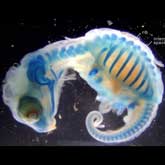How Does The Turtle Get Its Shell?
 Many invertebrates, such as beetles and lobsters, have shells, but the turtle is the only living vertebrate with a shell (except for the armadillo or course). A turtle's top shell is called the 'carapace', and the matching bottom shell is called the 'plastron.' How does a turtle get his pair of protective shells? Why he grows them of course!
Many invertebrates, such as beetles and lobsters, have shells, but the turtle is the only living vertebrate with a shell (except for the armadillo or course). A turtle's top shell is called the 'carapace', and the matching bottom shell is called the 'plastron.' How does a turtle get his pair of protective shells? Why he grows them of course!
While still inside the egg, a turtle embryo begins to look different from other vertebrates. Instead of curving around to form the familiar rib cage, the turtle embryo's ribs grow straight out from its backbone to form the oval framework of the carapace. The rest of the carapace is formed from calcified tissue deep in the skin of the back. This hardened layer is called dermal bone, and it grows around and fuses to the framework of ribs.
The lower shell, or plastron, is also made of calcified dermal tissue. The front part of the plastron, under the neck, is formed from the shoulder bones, called clavicles (these are dermal too). The rest of the plastron is made of dermal bone. The picture shows that even before it hatches, a baby turtle has begun to form its shell. When it hatches it will look just like an adult turtle, shell and all, only smaller.
About the Author
Sandy Becker, MA
 Sandy Becker received a BA in history from Pomona College. She then earned two MAs in Biology, and now has 25 years of experience in developmental biology research, working with mouse embryonic stem cells. Sandy began writing science articles about ten years ago to share her knowledge of science. She is currently studying for her third MA, in science journalism.
Sandy Becker received a BA in history from Pomona College. She then earned two MAs in Biology, and now has 25 years of experience in developmental biology research, working with mouse embryonic stem cells. Sandy began writing science articles about ten years ago to share her knowledge of science. She is currently studying for her third MA, in science journalism.


